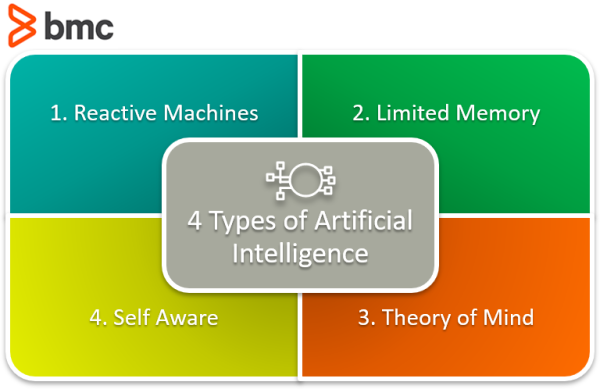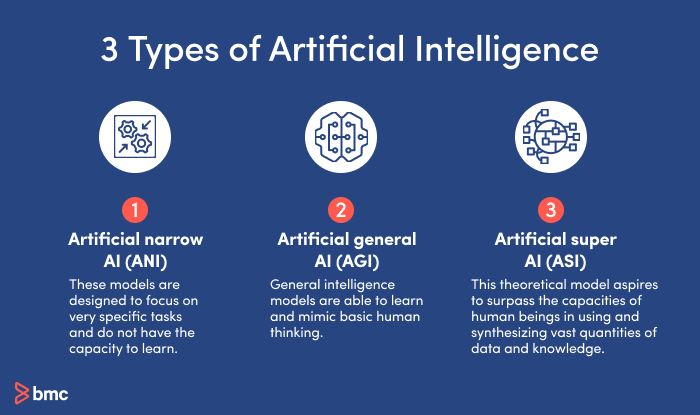Types of AI with Examples


Artificial intelligence (AI) has gone mainstream. We are experiencing an evolutionary leap forward in the technology and in its adoption and use. Once the exclusive domain of specialized technologists, now everyone is using it, from school children writing reports to employees using it for business applications. AI will soon have a role in nearly every corner of technology.
The pace of adoption and ongoing evolution of AI technology will only increase. As you track the trends, it is helpful to understand the various types of AI that are coming into common use.
The ways of organizing various approaches to AI are constantly evolving. In 2024, we can classify artificial intelligence into at least seven distinct types: three capabilities-based types and four functionality-based types that loosely correspond to Maslow’s hierarchy of needs. The simplest AI technologies match with the basic survival level of Maslow’s model. The most sophisticated levels of AI are self-aware, and match to the self-actualization level of that model.
The four functional types of AI are:
The current state of AI technology has evolved past the first type of reactive machines. The third and fourth types currently exist only in theory. They represent the next stage of AI—development.
Tech-oriented specialists organize different types of AI models according to how the AI is used, what its capabilities are, and how it helps advance humanity.
The three types of AI based on capabilities are:
 Here are overviews of the ways functionality-based AI is organized.
Here are overviews of the ways functionality-based AI is organized.
Reactive machine AI performs basic operations and represents the simplest level of artificial intelligence. These types react to some input with some output. There is no learning that occurs.
Reactive machine AI is the first stage to any AI system. A machine learning algorithm that takes a human face as input and outputs a box around the face to identify it as a face is a simple, reactive machine AI. The model stores no inputs and performs no learning.
Static machine learning models are reactive machines. Their architecture is the simplest and they can be found on GitHub repos across the web. These models can be downloaded, traded, passed around, and loaded into a developer’s toolkit with ease.
Limited memory AI can store previous data, using that data to make better predictions. With limited memory AI, machine learning architecture becomes a little more complex. Every machine learning model requires limited memory to be created, but the model can get deployed as a reactive machine type.
There are three major kinds of machine learning models that achieve this limited memory type:
While every machine learning model is created using limited memory, they don’t always become that way when deployed.
Limited memory AI works in two ways:
For machine learning infrastructure to sustain a limited memory AI type, the infrastructure requires machine learning to be built into its structure.
Active learning is increasingly more common in the machine learning lifecycle. The machine learning active learning cycle has six steps:
Technology is now beginning to evolve theory of mind AI types. This type of AI begins to interact with the thoughts and emotions of humans.
Current models have a one-way relationship with AI. A user issues a command to a system like Alexa or Siri, and they respond. They do not respond to emotions, so If you angrily yell at Google Maps to take you another direction, it does not offer emotional support, calm you down with assurances, or offer to inform someone that you’ll be late. Instead, it continues to return the same traffic reports and ETAs that it had already shown and has no concern for your distress.
ChatGPT is getting closer to a theory of mind AI. If you thank it for its help, it will graciously accept the compliment and express an eagerness to help more. You can also tell it how frustrated you are, and it will appear to commiserate.
Fields of study tackling this issue include Artificial Emotional Intelligence and developments in the theory of Decision-Making. Michael Jordan presented some of his Decision-Making research at the May 13, 2020 event, The Future of ML and AI with Michael Jordan and Ion Stoica, and more coverage was presented at the ICLR 2020 conference.
In the not-too-distant future, AI will become self-aware. This kind of AI exists only as a concept and in science fiction stories.
The potential is immense. At the same time, however, we have reason to fear the consequences of this evolution. It is possible for a self-aware AI, independent of the best of human values, to become adversarial to humans, and people will likely have to negotiate terms with the entity created.

These models are designed to focus on very specific tasks and do not have the capacity to learn.
General intelligence models are able to learn and mimic basic human thinking.
This theoretical model aspires to surpass the capacities of human beings in using and synthesizing vast quantities of data and knowledge.
The rapid evolution of AI technology naturally causes the propagation of additional names and classifications for types of AI models. Examples include:
However you define and classify AI models, the technology is here to stay. AI holds the potential to transform human creativity and capabilities in nearly every industry, from healthcare to finance to education and beyond.
While the positives are obvious, AI technology creates ethical issues and concerns that can affect society as a whole, touching on privacy, bias, government regulation, and security, to name a few. While people fear job loss, AI also creates new kinds of jobs.
With the right care and controls, AI can help humans take on complex global challenges and improve the lives of millions.